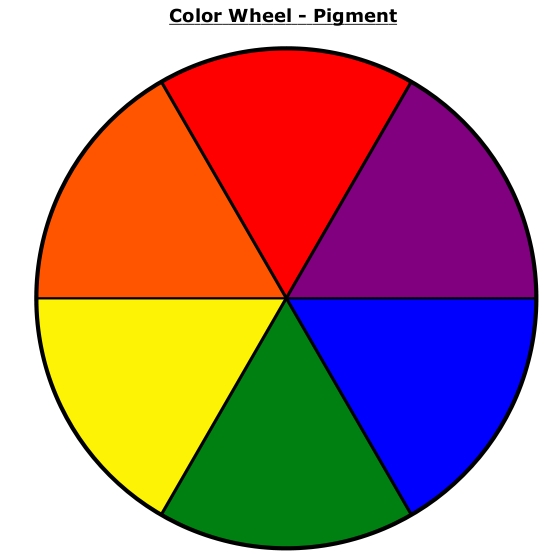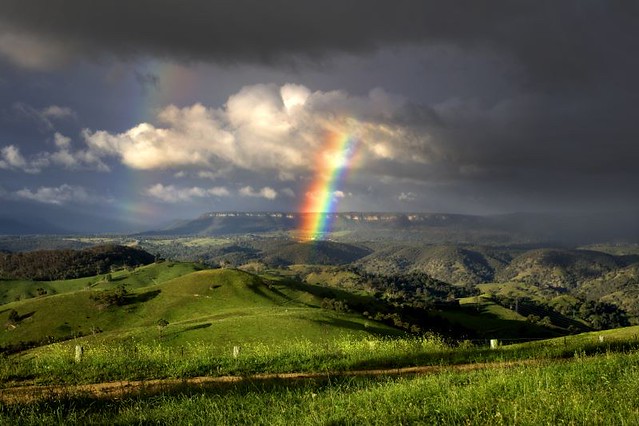Before I began public school, my mom had tapes that we would listen to that taught us many of the great folk songs like "Yankee Doodle Dandy", "Shoo, Fly, Don't Bother Me", and "Momma's Little Baby Loves Shortnin' Bread". One of the songs on these tapes was called "I Can Sing a Rainbow", by Arthur Hamilton. The lyrics are:
Red, and yellow, and pink, and green; purple, and orange, and blue. I can sing a rainbow, sing a rainbow, sing a rainbow, too.
So this is the rainbow that I learned. Imagine my horror when, in first grade, we were given an assignment to draw and color a rainbow—and I did what the song said! That fiendish cassette tape had led me astray![1] In vain I tried to convince my sneering peers that mine was right and theirs was wrong, but to no avail. Finally my Deeping Wall was breached when the teacher, Mrs. Point, sided with the class: the proper order of colors was red, orange, yellow, green, blue, indigo, violet. This proved the perfect opportunity for her to introduce us to that unfortunate mnemonic: Roy G. Biv.[2]
But by this time I was already suspicious of pedagogues who had clever ways of teaching the colors of the rainbow—they cannot, nay, must not be trusted![3] Who says violet? No one. It's purple. And who (in first grade) has ever heard of indigo? No, indigo and violet have no place in the rainbow.
When dealing with pigments, there are three primary colors: red, yellow, and blue. Combinations of these give rise to the three secondary colors: red + yellow = orange; yellow + blue = green; and red + blue = purple. When arranged in a wheel, each color ends up on the opposite side from its complementary color: red vs. green; orange vs. blue; and yellow vs. purple.[4] What is the complementary color for indigo? Burnt umber?
Now take a look at a rainbow. Is there really a separate band, equal to the others, for indigo? Of course not. Don't be silly. Red, orange, yellow, green, blue, purple. And you're done. So how did we end up with indigo and violet instead of just purple? We have Aristotle and Newton to blame (I know, more pedagogues). In fact, Newton originally described five basic colors but then decided to add two more (orange and indigo) so that the number of colors would equal the number of notes in a major scale (i.e. 7).[5]
ROYGBP doesn't readily lend itself to a silly mnemonic. But let's face it, if your kid can't remember the six colors, the lack of a good mnemonic is the least of their worries.[6] Just don't let them listen to "I Can Sing a Rainbow".
Notes:
[1] Apparently I'm not the only one. In 2008 Ed Balls, then Secretary of State for Children, Schools and Families of the United Kingdom, was publicly embarrassed by the same faux pas. See http://news.bbc.co.uk/2/hi/uk_news/politics/7179977.stm.
[2] I'm equally disdainful of the mnemonic "My Very Educated Mother Just Served Us Nine Pizza Pies (others have Eager, Elegant, or Energetic in place of Educated). First, I've been fascinated with the heavens from a very young age, so by the time my teachers tried to teach me the order and names of the planets I already had them memorized so I automatically found this useless and dumb. Second, if she's making that much food for her children, she's probably Enormous, not Energetic, Elegant, or Educated (though she might still be Eager). Third, "Pizza Pies" is two words, and who says that anyway (besides Dean Martin)? Perhaps the fact that Pluto has been downgraded to a dwarf planet will be a knell for this mnemonic.
[3] Another case of this misdirection is the rainbow marshmallows in Lucky Charms which are, inexplicably, blue on the outside, then yellow, and red on the inside.
[4] If you are dealing with light, the primary colors are: red, green, and blue. Combinations of these give rise to the three secondary colors: red + green = amber (yellow); green + blue = cyan; and red + blue = magenta. When arranged in a wheel, each color ends up on the opposite side from its complementary color: red vs. cyan; amber (yellow) vs. blue; and green vs. magenta.
[6] But don't give up on them. They might still have a promising future in the British Parliament.
Image attributions:
Pigment color wheel is by Lucas Benjaminh Krech, available at http://lucaskrech.com/blog/index.php/2010/01/04/color-theory-basics-hue/. A light color wheel can also be seen here.
Rainbow is by Roy (hopefully not G. Biv), available at http://www.flickr.com/photos/rwangsa/452128709/.


When I was a child, I argued that Sunday was the seventh day of the week because it was the day that we went to church and the Sabbath was the day that God rested. It made sense to me. I got mad when my cousins told me otherwise. It was years before anyone told me that Saturday was the seventh day and that the Sabbath had changed to Sunday on Christ's rising. But then "weekends" made much more sense. It's the beginning and end of the week, or the ends of the week.
ReplyDelete